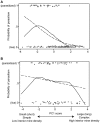Complex feeding tracks of the sessile herbivorous insect Ophiomyia maura as a function of the defense against insect parasitoids
- PMID: 22393419
- PMCID: PMC3290576
- DOI: 10.1371/journal.pone.0032594
Complex feeding tracks of the sessile herbivorous insect Ophiomyia maura as a function of the defense against insect parasitoids
Abstract
Because insect herbivores generally suffer from high mortality due to their natural enemies, reducing the risk of being located by natural enemies is of critical importance for them, forcing them to develop a variety of defensive measures. Larvae of leaf-mining insects lead a sedentary life inside a leaf and make conspicuous feeding tracks called mines, exposing themselves to the potential risk of parasitism. We investigated the defense strategy of the linear leafminer Ophiomyia maura Meigen (Diptera: Agromyzidae), by focusing on its mining patterns. We examined whether the leafminer could reduce the risk of being parasitized (1) by making cross structures in the inner area of a leaf to deter parasitoids from tracking the mines due to complex pathways, and (2) by mining along the edge of a leaf to hinder visually searching parasitoids from finding mined leaves due to effective background matching of the mined leaves among intact leaves. We quantified fractal dimension as mine complexity and area of mine in the inner area of the leaf as interior mine density for each sample mine, and analyzed whether these mine traits affected the susceptibility of O. maura to parasitism. Our results have shown that an increase in mine complexity with the development of occupying larvae decreases the probability of being parasitized, while interior mine density has no influence on parasitism. These results suggest that the larval development increases the host defense ability through increasing mine complexity. Thus the feeding pattern of these sessile insects has a defensive function by reducing the risk of parasitism.
Conflict of interest statement
Figures



References
-
- Evans DL, Schmict JO. Insect Defenses: Adaptive mechanisms and strategies of prey and predators. New York: State University of New York Press; 1990. 482
-
- Kato M. The adaptive significance of leaf-mining pattern as an anti-parasitoid strategy: a theoretical study. Res Popul Ecol. 1985;27:265–275.
-
- Djemai I, Meyhofer R, Casas J. Geometrical games between a host and a parasitoid. Am Nat. 2000;156:257–265. - PubMed
-
- Ayabe Y, Tuda M, Mochizuki A. Benefits of repeated mine trackings by a parasitoid when the host leafminer has a tortuous feeding pattern. Anim Behav. 2008;76:1795–1803.
MeSH terms
LinkOut - more resources
Full Text Sources

